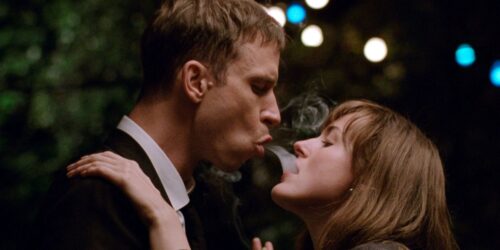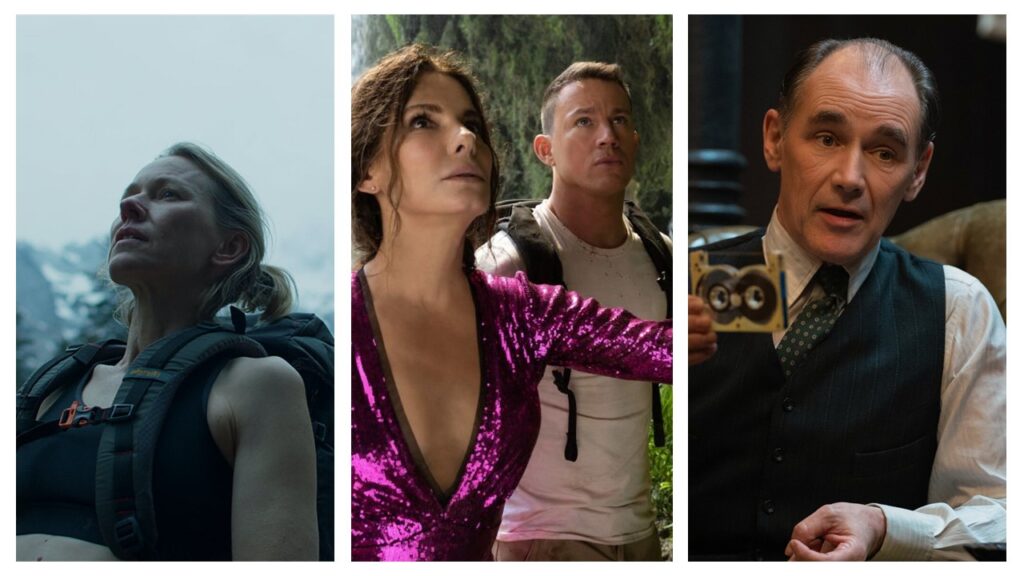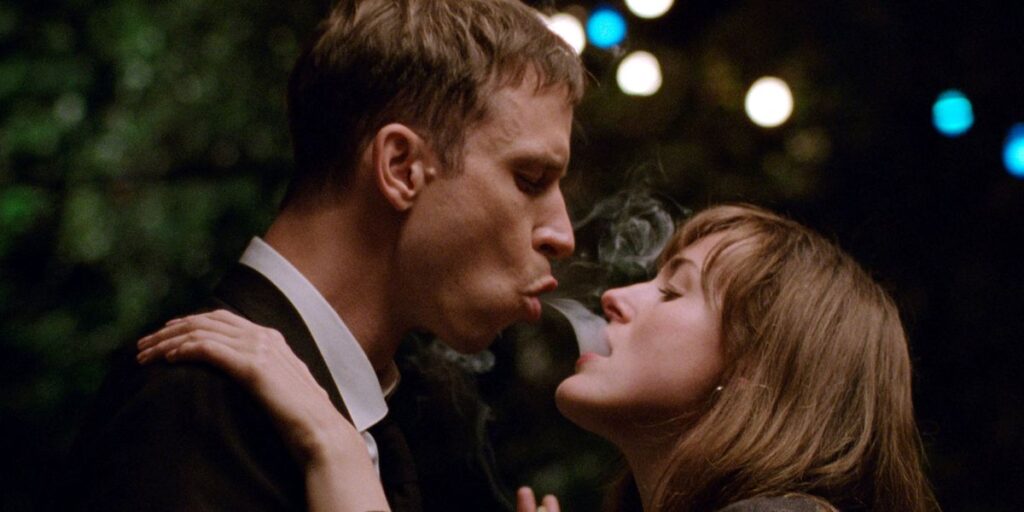By Lee Shoquist
While fantasy blockbusters dominated the American box office in 2021, the revenues for adult-oriented theatrical releases were dismal. As we move into a new and hopefully post-pandemic world where many are ready to safely return to cinemas, 2022 promises an uptick. Looking to the new year in film, several pictures in current release are highlighted in this review roundup.
The Outfit
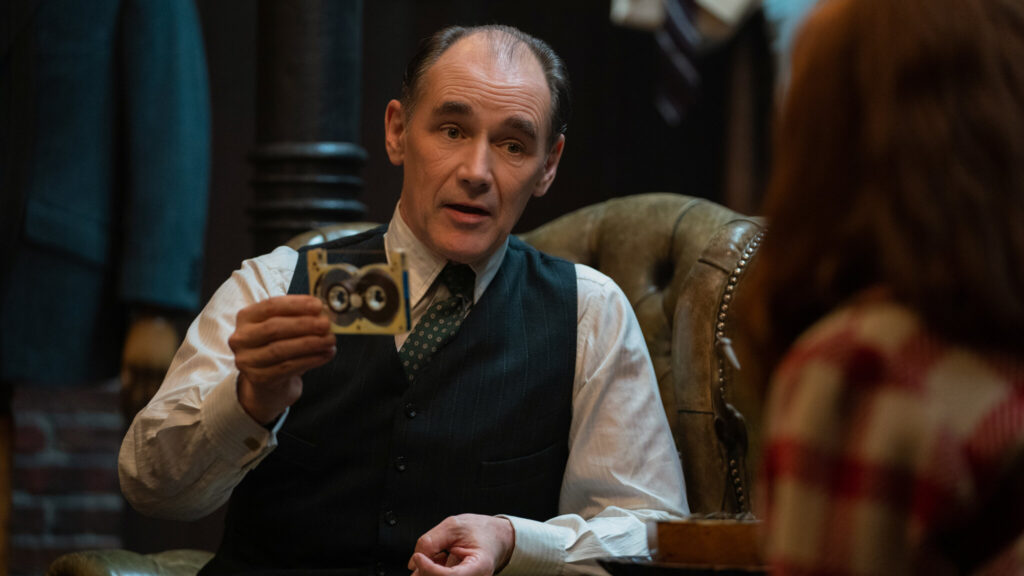
If you should refer to him as a tailor he will correct you—he’s a “cutter,” you see, and one of Chicago’s finest in the bespoke men’s attire business, quietly fitting and snipping and hemming suits as objets-d-art from within his fastidious south side atelier.
His name is Leonard Burling, played by a great Mark Rylance, and his defining talent—other than providing meticulous alterations—is recessive observation, the ability to see all, hear all and remain reticent, particularly when it comes to the underworld denizens frequenting his tiny shop. That shop and its tight quarters are the sole location for the minimalist The Outfit, a tensely coiled, 1956-set mob saga tiny in scale yet filled with big surprises.
Directed by Graham Moore (an Oscar winner for his The Imitation Game screenplay) and co-written by Moore and Johnathan McClain, The Outfit is not exactly a mafia picture in the traditional sense—there is no sprawl—as it all takes place in a confined location and is told in far lower key than say, Scorsese, Coppola or Leone. But it nonetheless contains the genre staples of shifting loyalties, double-crosses, sudden and ferocious violence and surprising, hidden identities. That all of this takes place in a claustrophobic clothing shop lends the picture both staginess and cleverness, a lean and mean example of storytelling in virtual real time; one could easily imagine the picture as an equally effective theatrical one-act.
Trained on London’s famed Savile Row (where Rylance interned to convincingly learn the trade), Leonard is most often referred to as “English” by the two-bit Chicago gangsters who frequent his shop as a clandestine gathering place and use its mysterious, backroom dropbox as a method of communicating. He sees nothing and hears nothing, but is aware of all, and keeps a near-paternal relationship with a young assistant, Mable (played with appealing moxie by Zoey Deutch), who dreams of leaving the Windy City behind for far more exotic locales.
The local mobsters include young Richie (a terrific Dylan O’Brien) and best friend and partner Francis (Johnny Flynn), and in the picture’s set-up they chide Leonard for his taciturn reservation. Richie is also secretly dating Mabel, a development from which nothing good will come. After Richie takes a bullet to his abdomen, Leonard, with needle and thread, is called upon to sew him up. And this development, the product of a rival mob dispute, thrusts the picture’s enjoyable maneuvers into high gear.
At the halfway point comes a terrific supporting performance, the sort of friendly menace so familiar to movie mafia tough guys who radiate civility and intimidation in equal measures and can alternate on a dime. That performance is by Royal Shakespeare Theatre veteran Sir Simon Russell Beale as Irish mafioso Roy Boyle, Richie’s father, who smells a rat when his son suddenly goes missing (and indeed there is a mysterious traitor in their midst). With forceful, contemplative glares and dramatic pauses, he exerts a glowering authority in direct contrast to Rylance’s understatement. And in the picture’s surprising climax, Boyle’s rival mob leader makes an appearance as one Violet La Fontaine, played with stylish sophistication by Nikki Amuka-Bird as a cool French customer in search of a mysterious and incriminating tape.
Moore’s narrative challenge, largely met, was crafting a maximalist plot on a decidedly minimalist set and much of the picture’s fun comes in its impressive physical chess game of how many characters populate the confined space. As they come and go, a body is hidden and stakes get raised, all within two rooms, and Moore makes superb use of his handsome set’s shades, doors, tables, drawers and windows.
The modest scale allows the actors to deliver the picture’s showmanship, and Moore’s overall approach of low-key, sly calibration, largely built on his dialogue, is refreshing in a film for adults that eschews the usual outsized action and hijinks that drive most modern crime thrillers.
Instead, The Outfit presents a pitch-perfect slow-burn of revelations, backtracks and surprises, beginning with Rylance, the famed Oscar-winner for Bridge of Spies and who had a rare off day recently as a flamboyant tech guru in Adam McKay’s flat-footed Don’t Look Up, proving that even the world’s great actors, at times, need a director.
Here the actor inspires fascination, drawing us to him for final reel expository revelations that force a re-evaluation of what we think we’ve known about the reticent gentleman, a model of subtlety until he isn’t, defined by his vocation until his past suddenly snaps into focus.
Infinite Storm
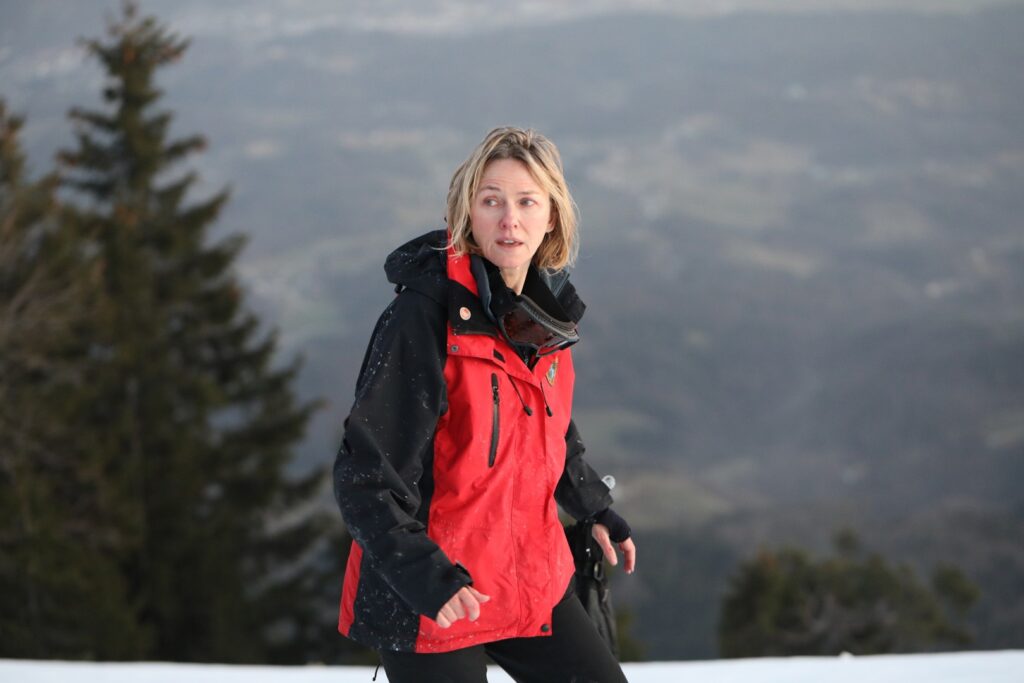
An undistinguished survivalist drama featuring Naomi Watts caught in a blizzard, Infinite Storm is a well-meaning but tepid retread of countless better films. The real-life story of New Hampshire search and rescue worker Pam Blanes, who in 2010 encountered a pair of extreme challenges during a six-mile hike up Mount Washington—a life-threatening storm of the century and a suicidal, ill-equipped hiker determined to die on its peak—it is sincere and well shot exercise in familiarity offering gorgeous locales but few surprises and little substance.
With a screenplay by Josh Rollins from Ty Gagne’s Reader’s Digest article High Places: Footprints in the Snow Lead to an Emotional Rescue and co-directed by Malgorzata Szumowska and Michael Englert (also the film’s cinematographer), it is a modest tale told in terms as literal as the title of its source material. It is also one with curiously blunted impact given its perilous premise, though Watts tries her damndest to layer an underwritten character with strength and humanity.
When we first meet Pam Blanes, who lives in solitude in a tiny, dark house beside a river, she drags herself out of bed on a chilly October morning and didactically prepares her hiking gear as a radio weather forecast warns of a cold day in store—a massive understatement. Blanes stops by the local general store for some light banter with the shopkeeper (Denis O’Hare) before heading up to the parking lot and trailhead at Mount Washington. There are hints at an underlying emotional condition when she remarks that the beauty of communing with nature is “cheaper than therapy.”
So far, so good—the stunning mountain cinematography (lensed in the Solvenian Alps) and aerial drone shots effectively exploit the natural setting, massive in scale and a foreboding vortex of deceptive grandeur, perhaps because we know what’s coming next as Blanes intrepidly forges into danger. We know little about Blanes (is she a lone hiker herself?) but it turns out that she is making a routine trek over a six-mile trail as a volunteer rescue resource. Arriving at the trailhead she notices a single car in the parking lot. Who is up on the mountain and are they aware of the impending weather conditions?
This first part of the film, as Pam makes her way vertical and star Watts pushes up steep inclines, trekking above the tree lines and across magnificent mountain ridges, is where the film excels, including a harrowing extended sequence where Blanes must extricate herself from a deep, icy hole. Watts, an actress whose signature is often balancing large emotions and intense physicality, thrusts herself into the herculean demands of the mountain, and role. As the wind quickly accelerates and the storm is swiftly upon her, the picture is structured with time indicators on the bottom of the screen (6:40am, 8:32am, 10:47am, etc.), a distracting and hackneyed device intended to suggest a race-against-the-clock flight to safety.
The story turns on Blanes’ discovery of high-elevation tennis shoe tracks in the deep snow, leading to a near catatonic, ill-equipped and likely suicidal young man (Billy Howle) whom she nicknames “John,” and the bulk of the film charts her efforts to get them both down the mountain safely. Predictably, this involves frostbitten toes, accidental slips and slides down steep declines, falls into rivers, a lot of yelling and other routine predicaments. Complicating Blanes’ struggle, John is also emotionally unbalanced and may not wish to be saved, making the journey back far more dangerous. Throughout, the film offers little spatial understanding of the mountain; Blanes seems to go up so quickly yet going down is a huge challenge. Perhaps there was far greater remaining distance on the trail, but the film is not explicit as to said distance or terrain, which seems important in a man against nature story.
Just over an hour into the picture they safely return to the parking lot, but John quickly speeds off without a thank you or goodbye. The final half-hour offers an eventual explanation for his actions as well as for Blanes’ past trauma, which we guessed far earlier. A scene of reconciliation offers the film’s one good line, which speaks to pushing through grief as “the whole universe appears as an infinite storm of beauty,” and suggests kindred souls brought together by circumstance, bonded in grief and buffeted by the kindness of strangers to get one through the dark places. Okay, sure, fine.
The principal problem in Infinite Storm is that we are given so little detail about its characters that they register less as dimensional people and more as mere character descriptions: Grieving Souls Unite to Survive and Share Life Lessons. The screenplay would have benefitted from some additional context on Bales’ life and perspectives. We know precisely two things about her—that she is grieving a tragedy and that she becomes an unlikely hero.
An always compelling star whose career was launched two decades ago by David Lynch in Mulholland Drive, the tremendously sympathetic Watts does all of the film’s heavy lifting (physically and emotionally), giving a performance that eclipses everything else onscreen. Appearing weather-beaten, aged and unfettered, she plunges into the considerable demands of the role with zero vanity and an emotional exposure that is her hallmark in pictures like 21 Grams and The Impossible, both of which brought her Oscar nominations. In fact, Infinite Storm merely calls on her to repeat her work in both of those films—both as a mother struggling with the painful loss of her children (21 Grams) and a woman thrust into an overwhelming natural disaster (as she did in The Impossible’s Thailand tsunami), left to fight her way out of both predicaments.
For anyone who hasn’t seen her daring portrait of a successful adult attorney with buried emotional issues over a childhood adoption trauma in Rodrigo Garcia’s 2009 Mother and Child, do so post haste. Ditto her morally complex contemporary mother in the 2019 indie drama Luce, a provocative role and performance. A uniquely skilled, prolific actress equally adept in small dramas like the Oscar-winning Birdman and huge commercial behemoths like Peter Jackson’s King Kong, she is underused in Infinite Storm and any substance the film achieves is squarely a result of her considerable efforts to fill in its blanks.
While the real-life story may be remarkable, as a movie An Infinite Storm is a human interest story that fails to generate much interest in its humans because it hasn’t given them enough to do. Extreme survival stories (The Impossible, 127 Hours, Everest) can be hard to watch given the visceral nature of survival, but this one is hard to watch because it fails to generate much investment in its characters. Consequently, it leaves us as cold, and stranded, as its characters in a waste of our time and Watts’ talents.
The Lost City
The Lost City, featuring Sandra Bullock as a jaded Manhattan romance novelist suddenly living one of her fictional adventures after being kidnapped to hunt for treasure amidst the jungles of the Caribbean, owes a few huge debts of gratitude, beginning with a heavy nod to Robert Zemeckis’ 1984 charmer Romancing the Stone, which it gleefully rips off, at least in its romantic adventure premise. Cribbing Kathleen Turner and Michael Douglas aside, perhaps its biggest debt is hitching itself to the charms of its star—well, three of them if you include co-stars Channing Tatum and Brad Pitt—in lieu of crafting nuanced characters or much substance. Fun? Yes. Memorable? Who cares?
The Lost City is a testament to a long-gone movie axiom, that of movie stars we like in situations that entertain us, giving us a couple hours of escape. Conventional thinking is that movie stars today are dead in an age of social media where we no longer need to see them larger-than-life onscreen because we carry them on small devices in our pockets. But The Lost City, a silly comic adventure and experiment in chemistry between a pair of affable stars, has in its best moments an undeniable charm. Both actors can do this material with their eyes closed, but when it works, it works.
The screenplay, by Oren Uziel, Dana Fox and co-director Adam Nee (with brother Aaron Nee), combines a healthy dose of Stone, a smidge of Indiana Jones lite and a cavalcade of one-liners in telling the story of Loretta Sage, suffering from writer’s block on her latest novel, a sort of female swashbuckler saga with a hardcore fan base of women obsessed with the series’ fictional romantic hero Dash, co-opted in real life by dim-witted hunk Alan (Channing Tatum), the series’ Fabio-esque cover model who considers himself a co-architect of the novels’ success.
In the wake of her archaeologist husband’s death and her creative juices stifled, Loretta nonetheless must promote her latest novel, goaded by her publisher, Beth (Da’Vine Joy Randolph) into an audience event with Alan that goes spectacularly off the rails. And then it goes even further awry when she is nabbed by one Abigail Fairfax (straight man Daniel Radcliffe), a filthy rich but otherwise useless magnate whose obsession with an illustration in her latest novel leads to an abducted Loretta spirited to a Caribbean island in search of an ancient, jeweled artifact named the Crown of Fire.
Alan, sensing his chance to prove to Loretta that he is every bit the real-life hero from her novels and not just the pretty face on the cover, springs into action, calling upon former Navy SEAL and yoga retreat leader Jack Trainer (a very funny Brad Pitt). Their rescue sequence is a hoot, and while Pitt’s appearance constitutes little more than a cameo, he nearly walks away with the film—his buddy-buddy routine with Tatum while dispatching baddies is the funniest sequence in an American film so far this year.
Once Loretta is freed—though still attached to a chair, in a plunging sequined dress and stilettos—the picture becomes a jungle chase that puts the stars through the requisite hijinks of climbing cliffs, navigating thick jungle brush, braving leech infested rivers (leading to a very funny moment where good sport Tatum nearly bares all), escaping periodic chases and, naturally, finding a few moments to fall for each other, whether sleeping together hammock style or cleaning up for a romantic tete-a-tete in a small jungle town. Turner and Douglas did this as well in their 1984 outing, dancing memorably and falling into more believable love in a better picture. This time, instead of Michael Douglas coming to the rescue, the modern twist is that Alan is the insecure, out of his element character who must prove his mettle and Loretta is largely the brains of their jungle escape.
The other star bolstering the picture’s appeal is the Dominican Republic island setting, captured with swooping drone deployment and, since it’s an American film in 2022, a healthy dose of CGI in the form of massive waterfalls and a bubbling volcano. Of course, the crater bides its time until the big climax set inside an ancient, set-decorated tomb, and then blasts off right on cue. In this and other ways, The Lost City feels like a quintessential summer movie released in March.
As always, Bullock knows her way around a pratfall, and at age fifty-seven impressively radiates vitality and her signature comic timing. She seems, and looks, about two decades her junior. And Tatum, who appears to be rapid-fire riffing in the film, is consistently funny as the babe in the woods desperate to earn Loretta’s respect and affections. Special mention goes to Randolph, so appealing in 2019’s Dolemite is My Name and good fun here, her Beth on a parallel trek to rescue Loretta by enlisting an eccentric cargo plane pilot played by The Office’s Oscar Nunez.
The Lost City will likely be a big hit—Bullock has uncanny instincts to star in them—and for simple entertainment you could do much worse. I enjoyed much of The Lost City for its sustained lunacy, and Tatum, especially, gives it his all.
The Worst Person in the World
There are a handful of moments in Joachim Trier’s The Worst Person in the World (currently streaming) where a young Norwegian woman, adrift across professions and relationships, gazes at the Oslo skyline in contemplation of significant life decisions. Has she made the right ones? What is coming next? What will ultimately satisfy her?
Trier, the forty-eight-year-old Copenhagen filmmaker is the writer and director of such pictures as Reprise, about a potentially suicidal writer; Oslo, August 31, which explored addiction, rehab and damaged relationships; Louder than Bombs, a solemn, American-set examination of a father and sons still reeling years after their matriarch’s death; and the unexpected Thelma, a thriller involving repression and telekinesis.
Accomplished as those pictures may be, The Worst Person in the World is easily Trier’s to-date best in its portrait of a refreshing, disarming (and often exasperating) modern woman searching for her elusive young identity. This hunt is endearing, offbeat and in the final analysis, forceful as a thunderclap. As navigated by Trier and his effervescent, Cannes-winning star Renate Reinsve, such considerations make for a daring romantic-comedy-drama—one that, if there were justice, would have claimed Oscars this year for its Best International Feature Film and Best Original Screenplay nods.
In a rapid-fire opening sequence, we meet Trier’s romantic heroine of sorts, Julie (Reinsve), who changes career paths and boyfriends on a whim. Initially, she’s a promising med student and future surgeon before abruptly switching gears to psychology. She then abandons medicine altogether in favor of photography. A similar restlessness informs her love life, switching boyfriends at will from an intellectual, flirtatious college professor to a sexy, gold-toothed fashion model. At one moment she’s a flashy blonde; the next, an earthy brunette.
In this set-up, Trier embraces a true-to-oneself wanderlust; a try everything, see what fits inquiry of contrasts and exploration—a philosophy that will inform Julie’s subsequent years and choices. As Francois Truffaut once famously said, “Taste is a result of a thousand distastes.” Trier’s Julie doesn’t quite know what she wants out of life, but over time she comes to know what she does not want.
Anyone with an artistic disposition has likely felt this tension, and perhaps witnessed others accomplishing clearly defined and attainable professional or life goals, often without even questioning them, and making outward strides—dream jobs, big promotions, bright futures and “adulting”—while one may still be doing menial or often mindless work, waiting for real life to begin or for the moment when everything becomes clear; when life’s purpose is finally revealed.
The Worst Person in the World considers such a disposition, spanning about four years and structured as a prologue, 12 chapters and an epilogue, an approach that eliminates traditional connective narrative tissue in favor of focusing on formative relationships and events. The first chapter begins at an Oslo party where Julie meets Aksel (a revelatory Anders Danielsen Lie), a cult comic book artist of note whose politically incorrect creation, Bobcat, has garnered a legion of followers. In his 40s, Aksel has immediate concerns that their relationship won’t last, telling twenty-something Julie that “If we go on, I’ll fall in love with you. Then it’ll be too late.”
The pair moves in together in classic rom-com fashion, Trier nodding to Annie Hall—a sophisticated and artistic older man opening the mind of a vivacious and offbeat younger woman, here bonding and bantering over how many shelves in his apartment she’s entitled to occupy. A budding writer herself who establishes viral notoriety after penning a radical feminist take on sex, Julie nonetheless feels more a witness to Aksel’s success than an architect of her own, explaining, “I feel like I’m playing a supporting role in my own life”.
The picture is smart about how easy it is to lose sight of one’s individual identity as one-half of a whole. He wants kids and is certain she will be a great mother; she has little interest. In a breakup scene of extraordinary tenderness, Aksel cautions Julie about severing their special connection—at 15 years he senior he knows such rarity.
Julie ultimately moves on to a younger barista, Eivand (Herbert Nordrum) and in one of the film’s most memorable sequences, they meet and navigate a heated flirtation without technically cheating, the line to which keeps getting fuzzier. Trier also mounts an original courtship moment where time stands still, Oslo’s residents frozen on city streets as Julie races into Eivand’s coffee house, the pair falling into each other’s arms. This is one of several innovative techniques Trier deploys to express Julie’s often unpredictable emotional states, also including a novel use of periodic narration and an expressionistic drug trip manifesting all of Julie’s anxieties.
Like Julie, Eviand is involved in a serious relationship, his with high-maintenance yoga guru Sunniva (Maria Graza de Meo), comically obsessed with global social justice causes. As Eivand says, “I’m the worst person in the world,” a self-effacing embrace of his infidelity and abandonment. But happiness is fleeting, and Julie again grows restless, this time bored with chemistry minus intellectual stimulation, and with Eivand’s lack of ambition.
There is a superb moment when Julie, having long left Aksel, catches him on a television interview, facing a female-led inquisition about the political correctness of his artistic vision. For Julie, this moment draws a stark contrast between paramours—the accomplished, older, passionate artist and the happy-go-lucky, aimless young barista. Was leaving Aksel a mistake?
The final act of The Worst Person in the World is suddenly, deeply affecting, and includes a poignant rumination on the fading glow of nostalgia for past generations: “I grew up in a time when culture was passed along through objects. They were interesting because we could live among them.” In these moments, star Lie (who has made three films with Trier) etches out a clear-eyed confrontation with mortality.
Reinsve is radiant throughout, and one of the keys to her performance is how Julie’s evolution registers on her face. Trier and co-writer Eskil Vogt never require her to deliver a monologue explaining her feelings or enlightening us to any evolved sense of self. Instead, the actress delivers Julie’s incremental growth with a measured, contemplative stillness. By the film’s close, Reinsve makes it clear that Julie knows exactly where she’s been, what has been important and where she is going.



